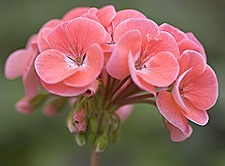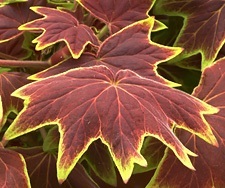Lush growing geraniums look good in a bed all by themselves, or mixed in with other annuals. They also make attractive edging plants for the flower garden.
In fact, these versatile plants are perfect for any spot that calls for a splash of vibrant color through-out the season.
And, of course, they’re always popular mainstays in containers, hanging baskets and window boxes, as they thrive in pots and mix beautifully with annuals such as lobelia, vinca vine, petunias and verbena.
Growing geraniums: popular types

Coral zonal geranium
The popular geraniums you find at most garden centers in spring actually belong to the genus Pelargonium.
They are from the same plant family as the hardy perennial Geranium, however, Pelargoniums are tender perennials and not frost hardy in cold regions.
The most common types fit into one of the following groups:
Zonal: This group is loved for its big, attractive flower heads that bloom white, pink, orange, red or purple. The leaves have a dark zonal pattern on the leaves.

‘Vancouver Centennial’ has attractive foliage
Fancy leaved: Some zonal geraniums have fancier leaves, edged or banded by colors such as yellow, white, burgundy or coral.
Ivy: This type has ivy-like leaves and a trailing habit, which makes them perfect for window boxes and hanging basket planters. The trailing types also tolerate a fair amount of shade.
Flower colors range from white through pastel shades of pink to red and purple.
Martha Washington or Regal: Large frilly flowers make these geraniums very special. They bloom in white and vivid colors such as orange, purple, red and burgundy. Regals thrive in part shade and can grow up to 4 feet tall.
Scented geraniums: These types that are gown primarily for their aromatic leaves with scents such as citrus, apple, rose or mint. These plants have smaller, less showy flowers than the other types. Citrus-scented cultivars, such as ‘Citronella’ are sold as mosquito repellent plants, although they are not very effective this purpose.
Other types of geraniums: There are dwarf types and a group known as stellars, which have star-shaped flowers and notched leaves. The award-winning ‘Vancouver Centennial’ (above) is one of the best known stellars.
Tips for growing geraniums:
Although they can weather a light frost, geraniums love to bask in warm-weather. Growing geraniums need:
Light: Most types flower best in full sun, which means at least six hours of direct sun a day. If you live in a hot region with regular summer temperature over 90 degrees F (32 degrees C), plant your geraniums in a partly shaded spot. Many geraniums do quite well in part shade, but they won’t flower as prolifically.
Soil: Geraniums like rich soil that is well drained. Compost added to your soil will give them an added boost. Plant container geraniums into pots filled with container potting mix.
Fertilizer: When growing geraniums, remember that they are heavy feeders. Give them fertilizer every two weeks or once a month at the very least. Use a balanced, water-soluble fertilizer such as 20-20-20, or feed them at planting time with a time-release fertilizer that lasts all season. Regular fertilizing is especially important for container-grown plants.
Water: The key thing about watering geraniums is to water them thoroughly, but let the soil dry between waterings. Be sure to water the plants regularly when it doesn’t rain. Check containers daily during hot summer weather. The best way to do this is to use a water meter or poke a finger into the soil. If it’s dry two inches down or more, it’s time to water.
Grooming: Leaves can die and turn brown for a number of reasons, mostly because geraniums are quite sensitive to fungal disease from excess moisture and humidity. Keep your plants looking their best by deadheading them and removing dried or discolored leaves. Your geraniums will reward you by looking great all season.
Over-wintering: You can grow geraniums indoors over winter, or take cuttings, or keep them dormant in a cool, dark basement. All the how-to Information is here.
Grow geraniums from seed
In the past, most commercially grown plants were propagated from cuttings.
But advances in plant breeding have changed that. There are now many excellent seed-grown varieties that outperform many older cutting-grown varieties. Get the how-to on growing geraniums from seed.
Geraniums and More
How to overwinter geraniums – plus how to take cuttings
How to start geraniums from seed




